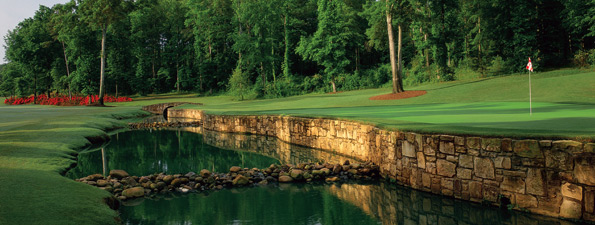Over the years, I had heard stories about golfers who had taken a quick lesson and arrived to a course expecting instant results. As a self-taught golfer—OK, I read a lot of instructional books—I couldn’t fathom what these people were talking about. As far as I was concerned, Rob Bowser at the Reynolds Golf Academy had set me on the path to ball-striking wellness. All I needed to do was show up and do what he said.
WRONG!
I didn’t throw my entire set of clubs in the lake at the Great Waters Course this morning, but I was sorely tempted. The real shame of it is, this Jack Nicklaus-designed layout, opened in 1992, is a brilliant test that has everything an avid player could want.

Jack, who early in his design career tended to rely on serious earthworks to create take-no-prisoners courses, decided to shelve his customary land features–exaggerated mounds, plateau fairways, miniscule greens–in favor of a playable, aesthetically pleasing course. Heroic efforts find their reward, yes, but cautious shots are not banished, which wasn’t always the case with Jack’s courses in the get-tough ’80s.
Handed a spectacular piece of land, Nicklaus delivered the goods but also exercised restraint. Half the holes at Great Waters flank the shores of Lake Oconee. Forced carries are rare: Most of the water is parallel to the line of play. The layout’s pleasant front nine runs inland through a pine forest, with a man-made creek in play at four greens. The peninsular back nine circulates players from one lake cove to the next. And while the challenge from the tips at 7,073 yards will get a good player’s attention, multiple sets of forward tees give everyone a chance to enjoy a user-friendly course that signaled a new direction for Jack as an architect. Great Waters playeis also the course that garnered national praise for Reynolds Plantation and thrust the resort community into an elite category.
The routing, one of Jack’s best, brings players to the brink of the lake at the ninth, a mid-length par 4 where the tee shot cascades to an open, descending fairway. Players must then cross one of the lake’s fingers to reach a green guarded in front and to the right by water. It is a preview of things to come, for the back nine at Great Waters, with a portion of each hole tracing the lakeshore and with six greens flush against the water, is to my mind the finest peninsula-and-cove golf experience in America. Here’s why: There’s just enough terra firma to offer strategic options and more than enough water to keep things interesting, especially when a breeze stirs off the lake.
Among the more intriguing holes on this dazzling stretch is the petite par-4 11th, which Nicklaus actually shortened during the design phase to tempt big hitters to try for the green with their drives. A 200-foot-wide peninsula green attached to the fairway by a narrow spit provides a generous target, but with water down the entire left side, a hooked drive is doomed to a watery grave. Believe me, I speak from experience.
The 14th and 17th holes are both bewitching par 3’s that require bold shots over the lake, while the stellar par-5 18th calls for a fair amount of planning in return for par. Once again, an inlet of the lake must be negotiated to reach a rock-rimmed green protected to the rear by a deep bunker designed to foil those who overclub to take the water out of play.
The biggest change from the last time I played here? The greens. Two years ago, the original bentgrass greens were resurfaced with Miniverde Bermudagrass, a unique varietal that thrives in this climate.
I grew up putting slick bentgrass greens in Westchester County, New York. Not even close. The greens on Great Waters are like greased lightning. Very true, but extremely fast.
I don’t know what the greens will be like next week at Augusta National during the Masters, but the way I’m playing, I doubt I’ll get a chance to find out if they’re any faster than the ones at Great Waters.
